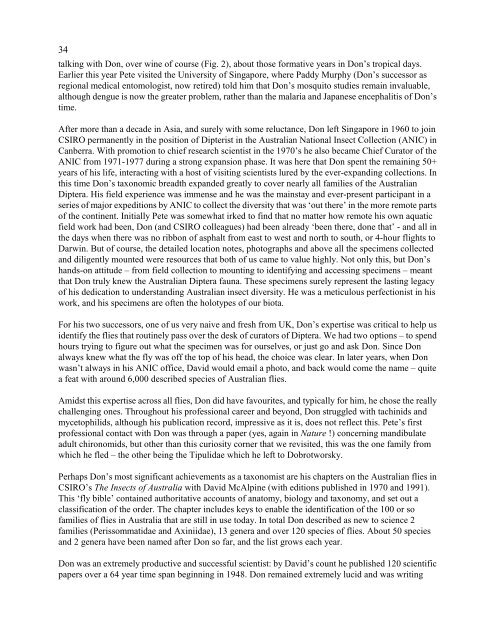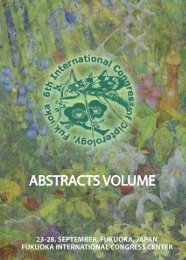Fly Times Issue 48, April 2012 - North American Dipterists Society
Fly Times Issue 48, April 2012 - North American Dipterists Society
Fly Times Issue 48, April 2012 - North American Dipterists Society
Create successful ePaper yourself
Turn your PDF publications into a flip-book with our unique Google optimized e-Paper software.
34<br />
talking with Don, over wine of course (Fig. 2), about those formative years in Don’s tropical days.<br />
Earlier this year Pete visited the University of Singapore, where Paddy Murphy (Don’s successor as<br />
regional medical entomologist, now retired) told him that Don’s mosquito studies remain invaluable,<br />
although dengue is now the greater problem, rather than the malaria and Japanese encephalitis of Don’s<br />
time.<br />
After more than a decade in Asia, and surely with some reluctance, Don left Singapore in 1960 to join<br />
CSIRO permanently in the position of Dipterist in the Australian National Insect Collection (ANIC) in<br />
Canberra. With promotion to chief research scientist in the 1970’s he also became Chief Curator of the<br />
ANIC from 1971-1977 during a strong expansion phase. It was here that Don spent the remaining 50+<br />
years of his life, interacting with a host of visiting scientists lured by the ever-expanding collections. In<br />
this time Don’s taxonomic breadth expanded greatly to cover nearly all families of the Australian<br />
Diptera. His field experience was immense and he was the mainstay and ever-present participant in a<br />
series of major expeditions by ANIC to collect the diversity that was ‘out there’ in the more remote parts<br />
of the continent. Initially Pete was somewhat irked to find that no matter how remote his own aquatic<br />
field work had been, Don (and CSIRO colleagues) had been already ‘been there, done that’ - and all in<br />
the days when there was no ribbon of asphalt from east to west and north to south, or 4-hour flights to<br />
Darwin. But of course, the detailed location notes, photographs and above all the specimens collected<br />
and diligently mounted were resources that both of us came to value highly. Not only this, but Don’s<br />
hands-on attitude – from field collection to mounting to identifying and accessing specimens – meant<br />
that Don truly knew the Australian Diptera fauna. These specimens surely represent the lasting legacy<br />
of his dedication to understanding Australian insect diversity. He was a meticulous perfectionist in his<br />
work, and his specimens are often the holotypes of our biota.<br />
For his two successors, one of us very naive and fresh from UK, Don’s expertise was critical to help us<br />
identify the flies that routinely pass over the desk of curators of Diptera. We had two options – to spend<br />
hours trying to figure out what the specimen was for ourselves, or just go and ask Don. Since Don<br />
always knew what the fly was off the top of his head, the choice was clear. In later years, when Don<br />
wasn’t always in his ANIC office, David would email a photo, and back would come the name – quite<br />
a feat with around 6,000 described species of Australian flies.<br />
Amidst this expertise across all flies, Don did have favourites, and typically for him, he chose the really<br />
challenging ones. Throughout his professional career and beyond, Don struggled with tachinids and<br />
mycetophilids, although his publication record, impressive as it is, does not reflect this. Pete’s first<br />
professional contact with Don was through a paper (yes, again in Nature !) concerning mandibulate<br />
adult chironomids, but other than this curiosity corner that we revisited, this was the one family from<br />
which he fled – the other being the Tipulidae which he left to Dobrotworsky.<br />
Perhaps Don’s most significant achievements as a taxonomist are his chapters on the Australian flies in<br />
CSIRO’s The Insects of Australia with David McAlpine (with editions published in 1970 and 1991).<br />
This ‘fly bible’ contained authoritative accounts of anatomy, biology and taxonomy, and set out a<br />
classification of the order. The chapter includes keys to enable the identification of the 100 or so<br />
families of flies in Australia that are still in use today. In total Don described as new to science 2<br />
families (Perissommatidae and Axiniidae), 13 genera and over 120 species of flies. About 50 species<br />
and 2 genera have been named after Don so far, and the list grows each year.<br />
Don was an extremely productive and successful scientist: by David’s count he published 120 scientific<br />
papers over a 64 year time span beginning in 19<strong>48</strong>. Don remained extremely lucid and was writing
















